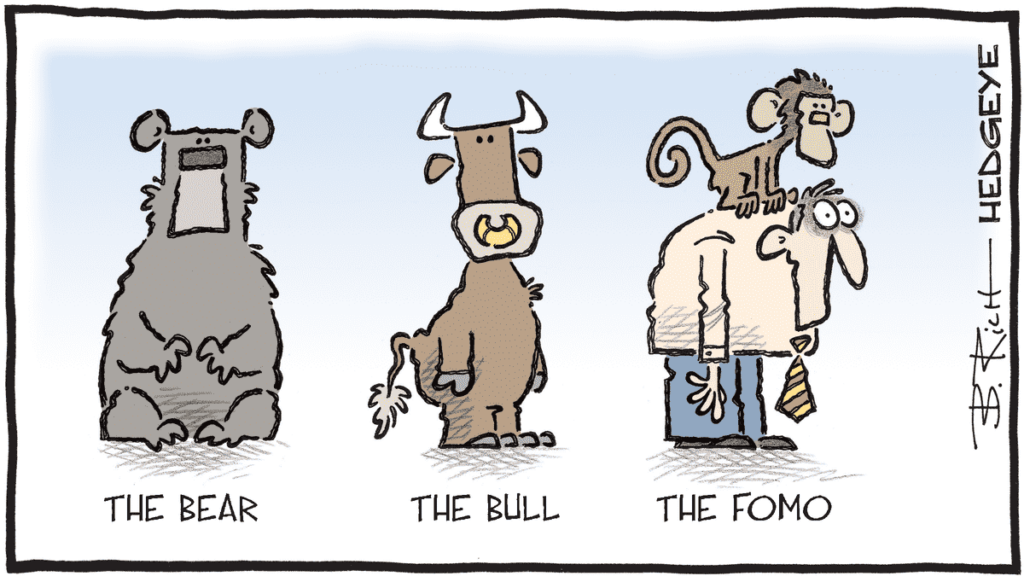
There are two ways to look at things when focusing on yesterday’s session. Either we delve into the details of everything we know and everything we speculate about the future of tariffs set to take effect on April 2—this column would then be about 14 pages long and we’d still be discussing it at 11 a.m.—or we simply summarize it using the words of a French comedian who left us too soon: “It is authorized to believe, in authorized circles, that a secret agreement MIGHT be reached on tariffs”—which would bring joy and relief while clearly acknowledging that we know NOTHING!
The Unrestrained Use of the Conditional
Yesterday’s trading day was split into two very distinct camps. Europe decided to do nothing—or at least, not much—while the U.S. markets took the path of gains, assuming that it MIGHT POSSIBLY MAYBE, but not for sure, be the case that the upcoming tariff decisions from Donald Trump’s administration won’t be as severe as expected. And that even if—at worst—they are as severe as predicted, the affected sectors could be carefully selected, with some parts of the economy EVEN receiving preferential tariffs. This was particularly true for the semiconductor sector, which rebounded yesterday based on speculation, rumors, and theories suggesting that things might not be as harsh for them.
But let’s be clear. If you go back through all the “justifications” for the U.S. rally and all the rational explanations for yesterday’s gains, the main takeaway is that the entire market surge on Monday, March 24, was based solely on speculation and the hope that the tariffs might be SLIGHTLY LESS brutal than expected. BUT NO ONE has seen an official press release. No media outlet has quoted an anonymous source “close to the matter.” No politician has made a cryptic remark hinting that they know something we don’t.
No. Yesterday’s U.S. rally—the 1.42% rise in the Dow Jones, the 1.76% gain in the S&P 500, the 2.27% surge in the Nasdaq, and the 3% increase in the Semiconductor Index—was entirely driven by the idea that, in the wonderful world of finance, tariffs set to be announced next week might not be as “monstrous” as feared, and that Trump could show some “flexibility” toward certain trade partners. But we know absolutely nothing, and everything—and I do mean ABSOLUTELY EVERYTHING—remains possible. Yesterday, the stars aligned, and we had a great day on Wall Street. However, it would take just the flap of a butterfly’s wings to send the market in the opposite direction in the coming days. Volumes were also dismal yesterday—hardly lending credibility to the strength of the rebound. The only certainty we have right now is that uncertainty remains high. Perhaps it’s best to simply take yesterday’s session as a temporary good news event and enjoy the moment, all while knowing that everything could evaporate in the blink of an eye—especially given the unpredictability of the Trump administration.
The U.S. session was all about champagne, confetti, and caviar by the spoonful, while European markets preferred to sit on their hands and wait for clearer skies. For weeks now, it has felt like we are living in two completely different worlds. Never before have European and U.S. markets been so disconnected.
Today, Europe is preparing for war on the continent, pouring money into military investments, unlocking credits left and right to fund the war effort, and completely ignoring structural issues like social welfare, economic slowdown, uncontrolled immigration, and questionable policies in certain EU countries. The war narrative has overshadowed everything else. Now, more time is spent discussing “patriotic bonds” to finance military spending than assessing the real state of the European economy.
Yesterday, European indices did nothing—except in the defense sector—as traders focused on European PMI data, which suggested that the economy “seems to be recovering” but isn’t quite back to the party mood yet. In summary, the manufacturing sector is doing better than the services sector across Europe. Still, overall, things were better than last month and roughly in line with expectations. Sure, these numbers don’t make you want to roll around in caviar, but at the same time, they’re not catastrophic either. If Trump doesn’t hit us too hard with tariffs, things should turn out okay.
As you can see, we’re still stuck in the same cycle: Tariff uncertainty fuels stress, and we just want to get past it to focus on fundamentals. Those fundamentals will soon return, as next week brings employment data, and by mid-April, earnings season will hit us once again.
So, to sum up: Europe did nothing yesterday. The U.S. market soared on almost nothing. Uncertainty remains high. Meanwhile, yesterday also marked the 25th anniversary of the dot-com bubble burst, leading the media to speculate whether we’re living through a similar scenario without realizing it. The answer is: NO! But scaring ourselves is so much fun that it would be a shame to pass up the opportunity.
On the Other Side of the World
In Asia, markets were mostly up this morning because the argument that “TARIFFS MIGHT BE LESS SEVERE THAN EXPECTED” is still driving enthusiasm. Japan is up 0.73%, China is up 0.12%, but Hong Kong is moving on, as traders there start questioning whether the recent rally driven by government stimulus in AI is losing steam. As a result, the Hang Seng is down 1.85%.
Oil, Cryptos, and the Latest from Trump
On the oil front, we actually had something official, as Donald Trump (yes, him again) announced a 25% tariff on imports from any country that dares to buy Venezuelan oil. Clearly, the White House is set on undermining the Venezuelan government by hitting where it hurts: the wallet. The news pushed crude oil up to $69 and some change. Again, with tariffs and uncertainty, it’s hard to know where things are headed. But for now, oil is reintegrating its medium-term bullish trend, and the risk of a major correction is (slightly) fading—but only slightly, because conditionality is in vogue.
Gold is at $3,047, and Bitcoin is trading at $86,500. Speaking of cryptos, MicroStrategy made headlines again after purchasing 6,911 bitcoins between March 17 and 23 for about $584.1 million, at an average price of $84,529 per Bitcoin. As of now, the company holds 506,137 bitcoins, and its stock surged 10% yesterday to celebrate the move.

In Other News
If we take a look at the “other news of the day”—yes, because the GOOD NEWS right now is that there are ALSO other topics that let us take a break from all the tariff discussions—among these other headlines, the standout is that Tesla surged more than 10% yesterday. This marks the fourth consecutive session of gains for Elon Musk’s company. The widespread dislike for him seems to be fading a bit, and we are also getting closer each day to the implementation of autonomous cars—a development that could push Tesla’s market cap to $10 trillion if everything goes according to plan. One thing is certain: in recent days, retail investors have returned to the stock en masse. This, combined with speculation that the new “FSD” (Full Self-Driving) software could soon be launched in China, helped propel the stock higher yesterday. Since March 11, Tesla has gained 30%.
Elsewhere, it’s worth noting that Adobe’s CEO just bought a large chunk of his company’s stock. While not groundbreaking in itself, the market has taken notice because he doesn’t do this often—and when he does, his timing tends to be impeccable. Given that Adobe’s stock took a beating after the last quarterly earnings report, investors are wondering if there might be an opportunity here.
Meanwhile, Super Micro was downgraded by Goldman Sachs. The investment bank now rates the stock as “SELL,” arguing that SMCI has lost its early competitive edge and expressing doubts about the company meeting its 2025 targets.
The world’s largest electric vehicle manufacturer and Tesla’s rival, BYD, announced a 34% jump in net profit, with revenue up 29% to 777.1 billion yuan, surpassing analyst estimates. The stock climbed 5.7% yesterday.
Nvidia advanced 3.2% on speculation that tariffs on semiconductor chips might be temporarily lifted.
Intuitive Machines jumped 30% despite issuing guidance slightly below expectations. The company still hopes to reach profitability by 2026. It’s difficult to predict the medium-term profitability of the space sector, but yesterday, Intuitive Machines investors were in a celebratory mood.
And later today, GameStop will release its quarterly results. Analysts expect nothing notable from GameStop’s core business, but there’s plenty of speculation about potential new ventures related to cryptocurrency. Stay tuned.
Today’s Economic Data
On the data front, as expected, we’ll see U.S. Consumer Confidence figures today—a key metric to watch. It will also be interesting to see “how the market reacts” to it. Additionally, Germany’s IFO Business Climate Index will be released.
One more thing to note: last night, Atlanta Fed President Raphael Bostic stated that, based on his own calculations, the Fed will only cut rates once this year due to what he described as “somewhat chaotic inflation.” At the moment, the market doesn’t seem to care much. Futures are down just 0.2%, and since midnight, Trump hasn’t lashed out at anyone.
Reminder: Tomorrow’s Conference
Lastly, a quick reminder that tomorrow evening at Uni Dufour, there will be a conference organized by Bilan and Vontobel on the topic:
“How Technology is Democratizing Investment for Young People.”It’s aimed at young people, but since we’re staying young for longer and longer, everyone is welcome to attend.

